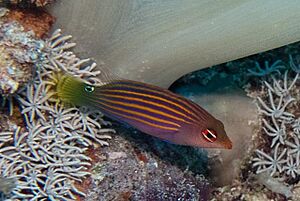Six-line wrasse facts for kids
Quick facts for kids Six-line wrasse |
|
|---|---|
 |
|
| Conservation status | |
| Scientific classification | |
| Synonyms | |
|
The six-line wrasse (Pseudocheilinus hexataenia) is a small, colorful fish. It is a type of ray-finned fish that belongs to the Labridae family. You can find this fish in many parts of the Indo-Pacific Ocean. It often lives near coral reefs and is also popular in home aquariums.
Contents
What Does the Six-line Wrasse Look Like?
The six-line wrasse is a very small fish. It grows to about 10 centimeters (4 inches) long. Its body is a pretty violet color. It has six bright orange stripes running along its sides.
You might also notice a small "eyespot" near its tail fin. It has a blue stripe along the bottom of its body, near the anal fin. Its pelvic fins also have a blue streak. The wrasse's eyes are a striking red color.
Where Does the Six-line Wrasse Live?
This fish lives in a very wide area. You can find it along the eastern coast of Africa, from the Red Sea all the way to South Africa. It also lives across the Indian Ocean.
In the Western Pacific Ocean, its home stretches north to Japan. It goes south to northern Australia. And it can be found as far east as the Tuamotu islands.
Life in the Reef: Habitat and Habits
The six-line wrasse loves to live among the branches of corals. You can find it in clear ocean waters. It also likes areas with lots of coral growth on the tops of reefs. Sometimes, it lives on the slopes of reefs in shallow water. It has been seen as deep as 20 meters (65 feet).
This fish is quite shy and likes to hide. You will usually see it in small groups. They swim among the corals, using them for protection. The six-line wrasse mainly eats small crustaceans.
Cleaner Fish Behavior
Sometimes, these wrasses act as "cleaner fish." This means they help other fish by removing tiny ectoparasites. These parasites, like copepods and isopods, live on the outside of other fish. The wrasse helps keep them clean and healthy.
Reproduction and Sleep Habits
In places like the Izu Islands of Japan, the six-line wrasse reproduces just before sunset. A male and female pair will quickly swim up towards the surface to release their eggs and sperm. This fast dash helps keep them safe from other fish that might try to eat them.
The six-line wrasse is active during the day. At night, it finds a safe spot in a coral or rock. It then creates a special "mucus cocoon" around itself to sleep. Scientists think this cocoon helps protect it from predators. It might hide the wrasse's scent, making it harder for night hunters to find.
Six-line Wrasse and People
The six-line wrasse is a very popular fish for home aquariums. People enjoy its bright colors and active nature. However, it is not usually bred in captivity. Most wrasses in aquariums are caught from the wild.
In some parts of Thailand, a group of people called the Sea Gypsies collect this fish. They use it as a food source.


